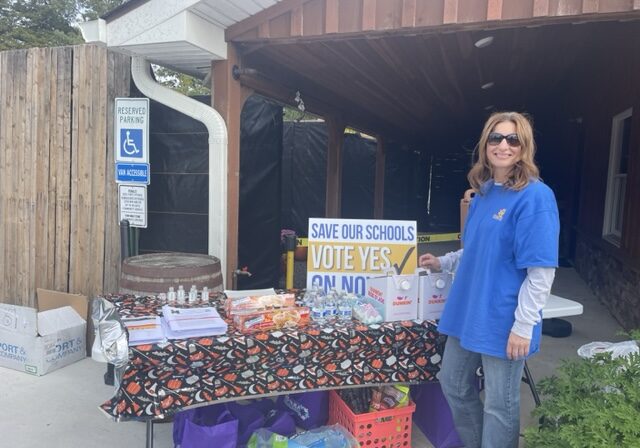By Kathryn Coulibaly
Waretown’s public schools needed help. They were confronted with laying off eight teachers and class sizes expanding to 30 students. Without an increase in taxes, they were in danger of losing local control over their two small-town schools and the education that so many people had sought out in moving to close-knit Waretown, also known as Ocean Township.
The loss of local control would have certainly seen higher per pupil costs thrust on taxpayers. With the second-lowest per pupil expenditures in the county, becoming a sending district any other schools in the county would have led to cost increases, without the ability to control them.
Waretown Education Association (WEA) President Alison Pohlman had been through contentious negotiations with the board, but when the president of the Waretown Board of Education, Shawn Denning, approached her about working together to pass a referendum, she and her members were completely on board.
“We have an excellent district full of highly qualified, dedicated educators,” Pohlman said. “We know the value our schools provide to this community, and the caring environment we cultivate in our schools. We didn’t want to lose a single member or see our students suffer as a result.”
Planning early and often
Beginning over the summer, the referendum team met to discuss strategies and ideas for how to successfully pass the ballot measure. The team included three board members, Pohlman, Priff Elementary Principal Ariane Solis, the head of the PTO, administrators, NJEA Field Representative Colleen Neil, and Denning.
“At the beginning, people were stuck on hypotheticals, there wasn’t much concrete action,” Neil said. “So I started by telling people to get their calendars out. We were going to plan something every week, up until Election Day.”
Neil brought in other NJEA resources, including organizer and political relations strategist Marybeth Beichert, communications support from Stephanie Natera and graphic designer Gregg Poserina, support from field representative Tom Bohnyak, and funding.
The WEA produced lawn signs supporting the schools and passed them out to community members. At back to school nights, there were information sessions so parents could ask questions about the referendum. There was a special board of education information session so members of the community could learn more. Representatives visited the retirement centers in the community to help voters appreciate what was at stake and how it would impact them. Events were also held at the local community center.
In the early fall, the team held a festival at Trailside Gardens, a private garden center across from the elementary school, with pumpkin painting for the kids, funded through NJEA’s Pride in Public Education program, and coffee and apple cider donuts. Members of the referendum team and WEA members stood on the street with signs urging support for the referendum, and parents who visited the festival received materials about the referendum.

Getting to “YES”
Closer to the election, they organized a door knocking campaign that ran like a well-oiled machine, thanks to Beichert’s expertise.
The WEA put out a mailing to all NJEA members who live in Waretown and Pohlman recorded a “robo call” reminding people to get out and vote yes.
At some of the events, they had people from the county clerk’s office checking voter status so people knew if their voter information was current, or if they needed to take action prior to the election to enable them to vote.
Superintendent Dr. Christopher Lommerin acquired big pieces of plywood and made signs reading “Vote YES,” putting them up all over town.
After the votes were counted, the referendum passed by a vote of 2123 to 2026. While it was closer than anyone would have liked, it showed the incredible odds the team was up against.
At the November board meeting, the president read a proclamation thanking the WEA, President Pohlman, and Neil.
“This campaign really changed relationships,” Pohlman said.
“I’ve always said to our counterparts who think that NJEA—or our local affiliates—are adversaries that we can do so much for our districts if we work together,” Neil said. “People who immediately take a rude or confrontational posture with NJEA staff or union leaders don’t understand that the relationship doesn’t have to be that way; we can help make things happen for the better in these districts when we work together.”
WEA is hopeful that this success will start a new chapter with the board and administration.
“In a million years, the board could not have passed this referendum without NJEA,” Neil said. “I think, at the end of the day, people’s eyes were really opened to the power of collaboration.”
Kathryn Coulibaly is the associate editor of the NJEA Review and provides content and support to njea.org. She can be reached at kcoulibaly@njea.org.
Best practices from Waretown
Neil encourages local associations to work with their field representative to develop communications resources that can help them in a crisis. Waretown already had a logo and was engaged in Pride activities. These assets helped them move quickly when they needed to.
